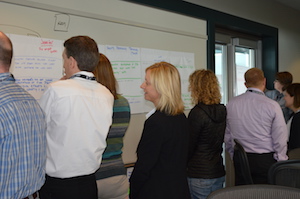Wisdom on academic change seems founded on seeing your desired shift from varying perspectives. For example, Bolman and Deal’s “Four frames,” which we use in our MACH workshops — that’s seeing a change from Political, Symbolic, Human Resource and Structural dimensions. Stopping to consider each of these points of view can generate ideas about how one’s hoped-for change will impact your organization, and ideas about what approaches are likely to be successful.
 Left — Participants at the 2015 MACH Workshop categorize their problems in different dimensions. What perspective will turn out to be the most productive, in guiding change?So, you may be thinking, for the most sweeping changes, perhaps the broadest possible perspectives can be useful? Well, what are those?
Left — Participants at the 2015 MACH Workshop categorize their problems in different dimensions. What perspective will turn out to be the most productive, in guiding change?So, you may be thinking, for the most sweeping changes, perhaps the broadest possible perspectives can be useful? Well, what are those?
It turns out we have already wrestled with that question in engineering — especially on large, multi-disciplinary projects which could affect people or things that aren’t in our direct line of sight. The field of “systems engineering” is the generic name for this area of work. Systems engineers love wicked, open-ended problems which seem almost impossible to solve, and they have developed ideas and methods to deal with these. They try to see these conundrums and their alternative solutions over time, via different angles, and from the eyes of many people.
Organizational motions, such as making academic change happen, are very similar to solving really messy technical problems. Indeed, the “people side” of some technologically based task may represent its biggest issues. It is not unusual for such engineering problem-solving acts to commence by listing a hundred or more conflicting stakeholders, for instance. Some of those want one feature, while others don’t want the product if it has that feature. Sound familiar?
What tricks do systems engineers have up their sleeves, which we might learn from? Here are examples of their practices:
* Cast it in writing: Put everything down and try to organize it as you go. This is an ongoing process, because you keep learning more basics as the work unfolds.
* Draw pictures showing what’s going on. How do things work now, and how will they work after the desired change is in place?
* Know your purpose well: What are the “goals” of this change which relate to your new way of working.
* Step back: “The big picture” has special value — the environment around your change and all the people and things that interact with it.
* Elevator pitch: Keep trying out the “features” of your change, and how they impact key stakeholders.
* How it will work: The “system” which is at the heart of your change — what’s new that must keep working and relating to everything else.
* The pieces that make it work: Be able to explain the “functions” inside that system which will make it provide services to the stakeholders outside.
* Who and what has to be a part of it, to cause those functions to happen.
Notice that these eight ways of looking at your change are all related, yet they are at varying levels of granularity and focused on the change from slightly different directions. For instance, having a somewhat systematic process yourself for going about the change — that’s not the same as taking time to represent the “system” you want to put in place which sustains the change. Nor is looking at “goals” the same as considering “features” or the “functions” which enable those features.
You may be thinking — “Hey, this process could get really messy,” even from the high-level view of systems engineering principles just listed. Well, that is true. However, systems engineers try for their processes NOT to get in the way of their solving the real problem at hand. They use these ideas as guidance, to suggest more things they should consider, or steps they might stop and do, and perhaps gain by that consideration.
So, feel free to “cherry pick” from this list, anything which might enhance what you are doing in your quest for academic change! And let me know if that helps…